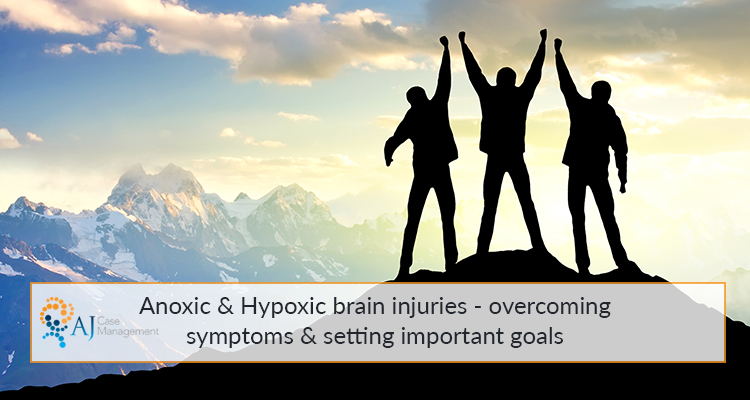
In this article we will discuss what a hypoxic and anoxic brain injury is and how the two compare, including how ischemic injuries are related to these conditions.
Read about signs and symptoms of these injuries and how to overcome them, such as finding the right support and the importance of setting goals. We have also included inspiring brain injury recovery stories.
What is the difference between hypoxic and anoxic brain injuries?
A hypoxic or anoxic brain injury is where the oxygen supply to the brain is interrupted.
The difference between these two terms is that a hypoxic injury involves a partial interruption of oxygen, whereas an anoxic brain injury involves a complete interruption of oxygen to the brain.
The brain needs a constant supply of oxygen as it is required to make use of glucose, which is its main source of energy. If this supply is cut off for more than 15 seconds, the person will lose consciousness.
If the supply is restricted for more than around 4 minutes, damage to the brain will start to occur.
The cerebral hemispheres (the largest parts of the brain) are mostly affected by these two conditions, although the terms are used when referring to a restricted oxygen supply to the entire brain.
Source: Headway.org.uk
What is an ischaemic brain injury?
Brain ischemia is a result of an insufficient blood supply to the brain.
The blood flow doesn’t meet the brains metabolic demand, which can lead to complications in its metabolism rate or a potential energy shortage.
As the brain requires such a large amount of energy, this can cause problems in the body such as a lack of movement, visual impairments or trouble with speech.
Ischemic and hypoxic brain injuries are often discussed as one injury, keep reading to find out how the two are related.
Hypoxic ischaemic brain injury definition – how the two conditions are related
An ischemic injury (a lack of blood supply to the brain) can lead to a hypoxic injury (a lack of oxygen supply to the brain).
This is because when there is a lack of blood supply, there is also a lack of oxygen as it is transported to the brain in our blood.
This condition can happen at any age, and there are different causes which can trigger it, one of which being a traumatic brain injury.
Although these two conditions can be related, they have some varying symptoms…
Signs and symptoms of an anoxic and hypoxic brain injury
If you suspect that you or a loved one has sustained a hypoxic or anoxic injury, it is vital you seek medical attention immediately. Here are some common signs of these conditions:
- Temporary memory loss
- Confusion
- Reduced attention span
- Vomiting
- Feeling light-headed or dizzy
- Pain in the head
- Reduced mobility
- Unfamiliar sensations in the body
These are temporary symptoms that may indicate a brain injury. It is important to act upon them if you suspect you are experiencing any of these signs.
If a hypoxic or anoxic injury has been sustained, there are symptoms that may affect the brain in the long term, such as changes in behaviour, difficulty with memory or psychological symptoms.
The severity of symptoms is different for everyone and will depends on a multitude of factors.
What’s important to remember is that with the right support, you can take back control of your life after a brain injury, set goals and reach milestones that will inspire you and those around you.
Keep reading to find advice for managing symptoms and how the right care plan can change your life…
Overcoming symptoms and creating an anoxic brain injury care plan
Symptoms can change on a daily basis which can easily become overwhelming when facing them on your own.
That is why building a network of support throughout rehabilitation is such a vital part of a care plan. No-one should face their symptoms alone, which is at AJ Case Management we are there every step of the way.
Here are some tips for managing symptoms and your emotional wellbeing:
- Don’t be afraid to reach out – you may want to complete tasks by yourself or manage on your own, but know when it’s time to ask for help. It may feel frustrating in the short term, but accepting help will aid you in your long-term recovery.
- Saying no is ok – rehabilitation is a time to focus on you, so don’t feel guilty for cancelling or changing plans if it is making you worried or anxious.
- Join support groups – although family members and friends may try their best to understand your injury, it can be therapeutic to speak to someone who is in your position. Joining support groups can be helpful for those wanting to discuss their struggles and celebrations.
- Coming to terms with a new routine – getting used to a new routine is difficult for anyone. A consistent routine is helpful for rehabilitation and it is also useful to assign additional time to daily tasks and activities so no extra stress or pressure is put on you.
- Seeking out the right help – managing all these new aspects to your life can quickly become overwhelming and stressful. Enquiring about a case manager can ease your journey to recovery and give you the support you need.
A case manager works with you and those around you to a deliver a tailored care plan that aids in a smooth journey to recovery.
We work with our clients every step of the way to make sure not only their physical rehabilitation is progressing, but to also make sure they are coping emotionally with their symptoms.
There are many forms of therapy that can support your physical and emotional wellbeing, such as counselling, occupational therapy or physiotherapy.
Here is how we can support you in reaching your goals after a hypoxic or anoxic brain injury…
Reaching your goals during anoxic brain injury rehabilitation
During hypoxic or anoxic brain injury rehabilitation it is important to set goals. Not only for the success of your rehabilitation, but also for your emotional wellbeing.
There are so many benefits to setting goals, a few of which include:
- Track your progress and measure where you are in your rehabilitation journey.
- It gives you direction and an insight into where you’re heading rather than feeling confused as to what the next steps are.
- It provides an opportunity to analyse your progress and discuss what is working and what isn’t.
- It allows you to take control of your rehabilitation and state what you want to get out of it.
- It can help your communication with others if you have a clear idea of what you’re trying to achieve and what needs to be done to reach your goals.
We are inspired by clients every day who are reaching incredible milestones and goals.
From going on a walk with friends to joining a family member for the weekly shop, we celebrate these brilliant achievements with you and support you with building a bright future.
Brain injury recovery stories – building a bright future
We are lucky enough to work with amazing people every day who truly inspire us with their unique stories.
In 2005, our case manager Ali was put in touch with a 12-year-old boy named GD.
He suffered a brain injury from a car accident in 2010 when he was 10 years old. His teachers were struggling to understand the injury and he wasn’t getting the support he needed in his education.
Ali put in place a support network to give him the same opportunities as his peers to flourish in his high school years.
He had the chance to develop his independent living skills, such as learning to manage his own finances and safely access his local community.
He is now 25 and has made a life changing recovery. He regularly attends the gym, has a fantastic group of friends and is learning to drive.
GD continuously plans opportunities for the future and looks forward to reaching even more of his goals.
To read more inspiring stories, take a look at our rehabilitation case studies page.

Recent Comments